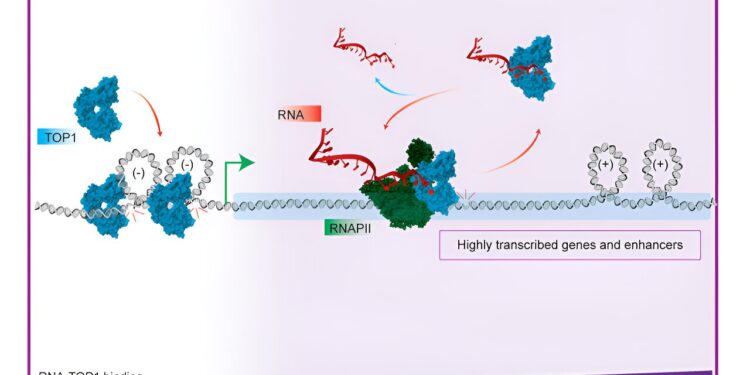Credit: Molecular cell (2024). DOI: 10.1016/j.molcel.2024.07.032
Scientists have discovered how interactions between RNA and the essential enzyme TOP1, which is overexpressed in many human cancers, regulate DNA during transcription and may shed light on the creation of new cancer therapies, according to a Northwestern Medicine study published in Molecular cell.
“This study provides new mechanistic insights that could pave the way for the development of novel chemotherapeutics by targeting the RNA binding interface with small compounds. Our results reveal that inhibition of TOP1 RNA binding may function similarly to well-known TOP1 inhibitors such as camptothecin by increasing catalytic complexes of TOP1 on DNA.
“This approach could induce genomic instability and potentially improve our ability to kill cancer cells,” said Shannon Lauberth, Ph.D., associate professor of biochemistry and molecular genetics and senior author of the study.
“By developing drugs that can precisely control the binding and release of TOP1-related RNAs, we can improve the efficacy of existing cancer therapies, but also make significant progress toward developing new therapies,” said Kouki Abe, Ph.D., a postdoctoral researcher in the Lauberth lab and co-first author of the study.
Topoisomerase I (TOP1) is an enzyme known for its role in preventing genomic instability by relieving torsional stress in DNA by introducing transient single-strand breaks. According to Lauberth, this DNA relaxation process prevents the accumulation of supercoiling and torsional stresses that could otherwise lead to DNA damage and instability.
“If this process doesn’t occur, transcription can be hampered, leading to double-stranded DNA breaks and genomic instability. This can cause cell death and trigger apoptosis,” said Lauberth, who is also a member of the Robert H. Lurie Comprehensive Cancer Center at Northwestern University.
In cancer cells, DNA transcription is often elevated, requiring increased levels of TOP1 activity to relax DNA and maintain proper gene expression, but the underlying mechanisms that regulate TOP1 activity remain unclear.
Using a combination of sequencing techniques and in vitro RNA binding assays, the researchers discovered that TOP1 binds to RNA, and that most of these RNAs are mRNAs, which carry the genetic information needed for protein synthesis.
The researchers then sought to better understand why TOP1 binds to RNA in relation to its essential role in DNA relaxation. Using DNA supercoiling experiments, single-molecule magnetic tweezers assays, and advanced sequencing methods, the researchers examined the catalytic activity of TOP1 and how it promotes interactions with DNA and RNA.
They found that RNA opposes TOP1 activity and, more importantly, that RNA polymerase II – a multiprotein complex that transcribes DNA into mRNA – activates the transcription process.
“Our study reveals a unique mechanism in which RNA modulates TOP1-mediated DNA relaxation, thereby playing a crucial role in regulating transcription. By identifying TOP1 as an RNA-binding protein, this research provides new insights into the interaction between RNA and DNA during transcription,” said Mannan Bhola, Ph.D., a data analyst in the Lauberth lab and co-first author of the study.
More information:
Mannan Bhola et al, RNA interacts with topoisomerase I to adjust DNA topology, Molecular cell (2024). DOI: 10.1016/j.molcel.2024.07.032. www.cell.com/molecular-cell/fu… 1097-2765(24)00630-0
Provided by Northwestern University
Quote:Study reveals role of RNA in regulating gene expression in cancer cells (2024, August 22) retrieved August 22, 2024 from
This document is subject to copyright. Apart from any fair dealing for the purpose of private study or research, no part may be reproduced without written permission. The content is provided for informational purposes only.



